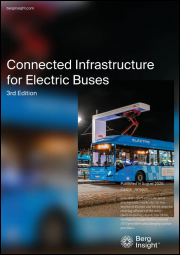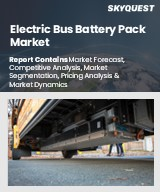
|
시장보고서
상품코드
1781477
세계의 배터리 전기버스 시장 조사 보고서 : 산업 분석, 규모, 점유율, 성장, 동향 및 예측(2025-2033년)Global Battery Electric Buses Market Research Report- Industry Analysis, Size, Share, Growth, Trends and Forecast 2025 to 2033 |
||||||
세계의 배터리 전기버스 시장 규모는 2024년 561억 달러에서 2033년에는 1,513억 8,000만 달러로 성장하고, 2026-2033년의 예측 기간에 11.66%의 연평균 복합 성장률(CAGR)을 나타낼 전망입니다.
배터리 전기버스 시장은 전 세계 도시들이 지속가능한 대중교통 솔루션을 우선시하는 가운데 패러다임의 전환을 경험하고 있습니다. 대기질과 온실가스 배출에 대한 우려가 커지면서 전기버스로의 전환은 도시 모빌리티 전략의 중요한 요소가 되고 있습니다. 배터리 전기버스는 기존 디젤 차량에 대한 깨끗한 대안을 제공하여 배기가스 및 소음 공해를 크게 줄일 수 있습니다. 각국 정부가 더 엄격한 환경 규제를 시행하고 전기 인프라에 투자함에 따라 배터리 전기버스의 채택이 가속화되고 대중교통 시스템의 미래가 재구성될 것으로 예측됩니다.
배터리 기술의 발전도 이 시장의 성장에 매우 중요한 역할을 하고 있습니다. 에너지 밀도, 충전 속도, 배터리 수명의 혁신은 교통 당국에 전기버스의 실현 가능성과 매력을 높이고 있습니다. 급속 충전소의 개발과 에너지 관리 시스템의 개선은 전기버스의 기존 차량에 대한 통합을 더욱 촉진하고 있습니다. 운영 비용이 낮아지고 성능이 향상됨에 따라 현대 도시 교통 수요를 충족시킬 수 있는 실행 가능한 솔루션으로 배터리 전기버스를 채택하는 운송 기관이 늘어날 것으로 예측됩니다.
또한, 민관이 협력하여 배터리 전기버스 시장 확대에 기여할 수 있는 환경이 조성되고 있습니다. 기술 제공업체, 에너지 기업, 인프라 개발 기업과의 파트너십은 전기버스 보급을 지원하는 종합적인 생태계를 구축하는 데 필수적입니다. 도시들이 스마트 교통 솔루션에 대한 투자를 계속하는 가운데, 배터리 전기버스 시장은 도시 이동을 위한 지속 가능하고 효율적인 대안을 제공함으로써 번창할 것으로 보입니다. 대중교통의 미래는 전기화이며, 도시 경관을 바꾸고 주민의 삶의 질을 향상시킬 수 있는 가능성을 이해관계자들이 인식하고 있기 때문에 배터리 전기버스는 점점 더 많은 추진력을 얻고 있습니다.
당사의 보고서는 고객에게 다양한 산업과 시장에 대한 종합적이고 실용적인 통찰력을 제공하기 위해 세심하게 작성되었습니다. 각 보고서는 시장 상황을 완전히 이해하기 위해 몇 가지 중요한 요소를 포함하고 있습니다.
시장 개요: 정의, 분류, 산업 현황 등 시장에 대한 자세한 소개.
시장 역학: 시장 성장에 영향을 미치는 주요 촉진요인, 억제요인, 기회 및 과제를 상세하게 분석합니다. 이 섹션에서는 기술 발전, 규제 변화, 새로운 트렌드 등의 요인을 살펴봅니다.
세분화 분석 : 제품 유형, 용도, 최종 사용자, 지역 등의 기준에 따라 시장을 명확한 부문으로 세분화합니다. 이 분석을 통해 각 부문의 실적과 미래성을 파악할 수 있습니다.
경쟁 구도: 시장 점유율, 제품 포트폴리오, 전략적 이니셔티브, 재무 실적 등 주요 시장 진출기업의 종합적인 평가. 주요 기업들이 채택하고 있는 경쟁 역학 및 주요 전략에 대한 고찰을 담고 있습니다.
시장 예측 : 과거 데이터와 현재 시장 상황을 바탕으로 일정 기간 시장 규모와 성장 추세를 예측합니다. 여기에는 정량적 분석과 미래 시장 궤적을 보여주는 그래프 표시가 포함됩니다.
지역 분석 : 지역별 시장 성과를 평가하고 주요 시장 및 지역 동향을 파악합니다. 지역 시장 역학 및 비즈니스 기회를 이해하는 데 도움이 됩니다.
새로운 트렌드와 기회 : 현재 시장 동향과 새로운 시장 동향, 기술 혁신, 잠재적 투자 대상 부문을 식별합니다. 향후 개발 및 성장 전망에 대한 통찰력을 담고 있습니다.
목차
제1장 서문
제2장 주요 요약
- 시장 하이라이트
- 세계 시장 현황
제3장 배터리 전기버스 산업 분석
- 서론 : 시장 역학
- 시장 성장 촉진요인
- 시장 성장 억제요인
- 시장 기회
- 산업 동향
- Porter의 Five Forces 분석
- 시장 매력 분석
제4장 밸류체인 분석
- 밸류체인 분석
- 원료 분석
- 원료 리스트
- 원료 제조업체 리스트
- 주요 원료 가격 동향
- 잠재적 바이어 리스트
- 마케팅 채널
- 직접 마케팅
- 간접 마케팅
- 마케팅 채널 발전 동향
제5장 세계의 배터리 전기버스 시장 분석 : 배터리 유형별
- 배터리 유형별 개요
- 배터리 유형별 과거 및 예측 데이터 분석
- 리튬 이온
- 니켈 수소
- 고체 배터리
- 기타
제6장 세계의 배터리 전기버스 시장 분석 : 용도별
- 용도별 개요
- 용도별 과거 및 예측 데이터 분석
- 공공 교통
- 민간 차량
- 통학 버스
- 기타
제7장 세계의 배터리 전기버스 시장 분석 : 충전 인프라별
- 충전 인프라별 개요
- 충전 인프라별 과거 및 예측 데이터 분석
- 창고 충전
- 기회 충전
- 기타
제8장 세계의 배터리 전기버스 시장 분석 : 버스 길이별
- 버스 길이별 개요
- 버스 길이별 과거 및 예측 데이터 분석
- 9미터 이하
- 9-14미터
- 14미터 이상
제9장 세계의 배터리 전기버스 시장 분석 : 지역별
- 지역별 전망
- 서론
- 북미의 판매 분석
- 개요, 분석과 예측
- 북미 : 부문별
- 북미 : 국가별
- 미국
- 캐나다
- 멕시코
- 유럽의 판매 분석
- 개요, 분석과 예측
- 유럽 : 부문별
- 유럽 : 국가별
- 영국
- 프랑스
- 독일
- 이탈리아
- 러시아
- 기타 유럽
- 아시아태평양의 판매 분석
- 개요, 분석과 예측
- 아시아태평양 : 부문별
- 아시아태평양 : 국가별
- 중국
- 인도
- 일본
- 한국
- 호주
- 동남아시아
- 기타 아시아태평양
- 라틴아메리카의 판매 분석
- 개요, 분석과 예측
- 라틴아메리카 : 부문별
- 라틴아메리카 : 국가별
- 브라질
- 아르헨티나
- 페루
- 칠레
- 기타 라틴아메리카
- 중동 및 아프리카의 판매 분석
- 개요, 분석과 예측
- 중동 및 아프리카 : 부문별
- 중동 및 아프리카 : 국가별
- 사우디아라비아
- 아랍에미리트(UAE)
- 이스라엘
- 남아프리카공화국
- 기타 중동 및 아프리카
제10장 배터리 전기버스 기업 경쟁 구도
- 배터리 전기버스 시장 경쟁
- 제휴/협력/계약
- 인수합병(M&A)
- 신제품 발매
- 기타 개발
제11장 기업 개요
- 주요 기업의 시장 점유율 분석
- 시장 집중도
- BYD Company Limited
- Proterra Inc.
- Yutong Bus Co. Ltd.
- NFI Group Inc.
- AB Volvo
- Daimler AG
- Solaris Bus & Coach S.A.
- Ebusco B.V.
- VDL Groep
- Anhui Ankai Automobile Co. Ltd.
- King Long United Automotive Industry Co. Ltd.
- Zhongtong Bus Holding Co. Ltd.
- Alexander Dennis Limited
- Blue Bird Corporation
- Gillig LLC
Global Battery Electric Buses Market size is anticipated to grow from USD 56.1 Billion in 2024 to USD 151.38 Billion by 2033, showcasing a robust Compound Annual Growth Rate (CAGR) of 11.66% during the forecast period of 2026 to 2033.
The battery electric buses market is experiencing a paradigm shift as cities worldwide prioritize sustainable public transportation solutions. With growing concerns over air quality and greenhouse gas emissions, the transition to electric buses is becoming a critical component of urban mobility strategies. Battery electric buses offer a cleaner alternative to traditional diesel-powered vehicles, significantly reducing emissions and noise pollution. As governments implement stricter environmental regulations and invest in electric infrastructure, the adoption of battery electric buses is expected to accelerate, reshaping the future of public transit systems.
Technological advancements in battery technology are also playing a pivotal role in the growth of this market. Innovations in energy density, charging speed, and battery lifespan are enhancing the feasibility and attractiveness of electric buses for transit authorities. The development of fast-charging stations and improved energy management systems is further facilitating the integration of electric buses into existing fleets. As operational costs decrease and performance improves, more transit agencies are likely to embrace battery electric buses as a viable solution for meeting the demands of modern urban transportation.
Moreover, the collaboration between public and private sectors is fostering a conducive environment for the expansion of the battery electric bus market. Partnerships with technology providers, energy companies, and infrastructure developers are essential for creating a comprehensive ecosystem that supports the deployment of electric buses. As cities continue to invest in smart transportation solutions, the battery electric bus market is set to flourish, offering a sustainable and efficient alternative for urban mobility. The future of public transportation is electric, and the momentum behind battery electric buses is only expected to grow as stakeholders recognize their potential to transform urban landscapes and improve the quality of life for residents.
Our reports are meticulously crafted to provide clients with comprehensive and actionable insights into various industries and markets. Each report encompasses several critical components to ensure a thorough understanding of the market landscape:
Market Overview: A detailed introduction to the market, including definitions, classifications, and an overview of the industry's current state.
Market Dynamics: In-depth analysis of key drivers, restraints, opportunities, and challenges influencing market growth. This section examines factors such as technological advancements, regulatory changes, and emerging trends.
Segmentation Analysis: Breakdown of the market into distinct segments based on criteria like product type, application, end-user, and geography. This analysis highlights the performance and potential of each segment.
Competitive Landscape: Comprehensive assessment of major market players, including their market share, product portfolio, strategic initiatives, and financial performance. This section provides insights into the competitive dynamics and key strategies adopted by leading companies.
Market Forecast: Projections of market size and growth trends over a specified period, based on historical data and current market conditions. This includes quantitative analyses and graphical representations to illustrate future market trajectories.
Regional Analysis: Evaluation of market performance across different geographical regions, identifying key markets and regional trends. This helps in understanding regional market dynamics and opportunities.
Emerging Trends and Opportunities: Identification of current and emerging market trends, technological innovations, and potential areas for investment. This section offers insights into future market developments and growth prospects.
SEGMENTATION COVERED IN THE REPORT
By Battery Type
- Lithium-ion
- Nickel-Metal Hydride
- Solid-State
- Others
By Application
- Public Transit
- Private Fleet
- School Buses
- Others
By Charging Infrastructure
- Depot Charging
- Opportunity Charging
- Others
By Bus Length
- Less than 9 meters
- 9-14 meters
- Above 14 meters
- COMPANIES PROFILED
- BYD Company Limited
- Proterra Inc.
- Yutong Bus Co. Ltd.
- NFI Group Inc.
- AB Volvo
- Daimler AG
- Solaris Bus & Coach S.A.
- Ebusco B.V.
- VDL Groep
- Anhui Ankai Automobile Co. Ltd.
- King Long United Automotive Industry Co. Ltd.
- Zhongtong Bus Holding Co. Ltd.
- Alexander Dennis Limited
- Blue Bird Corporation
- Gillig LLC.
- The above list can be customized.
TABLE OF CONTENTS
1. PREFACE
- 1.1. Report Description
- 1.1.1 Objective
- 1.1.2 Target Audience
- 1.1.3 Unique Selling Proposition (USP) & offerings
- 1.2. Research Scope
- 1.3. Research Methodology
- 1.3.1 Market Research Process
- 1.3.2 Market Research Methodology
2. EXECUTIVE SUMMARY
- 2.1. Highlights of Market
- 2.2. Global Market Snapshot
3. BATTERY ELECTRIC BUSES INDUSTRY ANALYSIS
- 3.1. Introduction - Market Dynamics
- 3.2. Market Drivers
- 3.3. Market Restraints
- 3.4. Opportunities
- 3.5. Industry Trends
- 3.6. Porter's Five Force Analysis
- 3.7. Market Attractiveness Analysis
- 3.7.1 Market Attractiveness Analysis By Battery Type
- 3.7.2 Market Attractiveness Analysis By Application
- 3.7.3 Market Attractiveness Analysis By Charging Infrastructure
- 3.7.4 Market Attractiveness Analysis By Bus Length
- 3.7.5 Market Attractiveness Analysis By Regions
4. VALUE CHAIN ANALYSIS
- 4.1. Value Chain Analysis
- 4.2. Raw Material Analysis
- 4.2.1 List of Raw Materials
- 4.2.2 Raw Material Manufactures List
- 4.2.3 Price Trend of Key Raw Materials
- 4.3. List of Potential Buyers
- 4.4. Marketing Channel
- 4.4.1 Direct Marketing
- 4.4.2 Indirect Marketing
- 4.4.3 Marketing Channel Development Trend
5. GLOBAL BATTERY ELECTRIC BUSES MARKET ANALYSIS BY BATTERY TYPE
- 5.1. Overview By Battery Type
- 5.2. Historical and Forecast Data Analysis By Battery Type
- 5.3. Lithium-ion Historic and Forecast Sales By Regions
- 5.4. Nickel-Metal Hydride Historic and Forecast Sales By Regions
- 5.5. Solid-State Historic and Forecast Sales By Regions
- 5.6. Others Historic and Forecast Sales By Regions
6. GLOBAL BATTERY ELECTRIC BUSES MARKET ANALYSIS BY APPLICATION
- 6.1. Overview By Application
- 6.2. Historical and Forecast Data Analysis By Application
- 6.3. Public Transit Historic and Forecast Sales By Regions
- 6.4. Private Fleet Historic and Forecast Sales By Regions
- 6.5. School Buses Historic and Forecast Sales By Regions
- 6.6. Others Historic and Forecast Sales By Regions
7. GLOBAL BATTERY ELECTRIC BUSES MARKET ANALYSIS BY CHARGING INFRASTRUCTURE
- 7.1. Overview By Charging Infrastructure
- 7.2. Historical and Forecast Data Analysis By Charging Infrastructure
- 7.3. Depot Charging Historic and Forecast Sales By Regions
- 7.4. Opportunity Charging Historic and Forecast Sales By Regions
- 7.5. Others Historic and Forecast Sales By Regions
8. GLOBAL BATTERY ELECTRIC BUSES MARKET ANALYSIS BY BUS LENGTH
- 8.1. Overview By Bus Length
- 8.2. Historical and Forecast Data Analysis By Bus Length
- 8.3. Less than 9 meters Historic and Forecast Sales By Regions
- 8.4. 9-14 meters Historic and Forecast Sales By Regions
- 8.5. Above 14 meters Historic and Forecast Sales By Regions
9. GLOBAL BATTERY ELECTRIC BUSES MARKET ANALYSIS BY GEOGRAPHY
- 9.1. Regional Outlook
- 9.2. Introduction
- 9.3. North America Sales Analysis
- 9.3.1 Overview, Historic and Forecast Data Sales Analysis
- 9.3.2 North America By Segment Sales Analysis
- 9.3.3 North America By Country Sales Analysis
- 9.3.4 United States Sales Analysis
- 9.3.5 Canada Sales Analysis
- 9.3.6 Mexico Sales Analysis
- 9.4. Europe Sales Analysis
- 9.4.1 Overview, Historic and Forecast Data Sales Analysis
- 9.4.2 Europe By Segment Sales Analysis
- 9.4.3 Europe By Country Sales Analysis
- 9.4.4 United Kingdom Sales Analysis
- 9.4.5 France Sales Analysis
- 9.4.6 Germany Sales Analysis
- 9.4.7 Italy Sales Analysis
- 9.4.8 Russia Sales Analysis
- 9.4.9 Rest Of Europe Sales Analysis
- 9.5. Asia Pacific Sales Analysis
- 9.5.1 Overview, Historic and Forecast Data Sales Analysis
- 9.5.2 Asia Pacific By Segment Sales Analysis
- 9.5.3 Asia Pacific By Country Sales Analysis
- 9.5.4 China Sales Analysis
- 9.5.5 India Sales Analysis
- 9.5.6 Japan Sales Analysis
- 9.5.7 South Korea Sales Analysis
- 9.5.8 Australia Sales Analysis
- 9.5.9 South East Asia Sales Analysis
- 9.5.10 Rest Of Asia Pacific Sales Analysis
- 9.6. Latin America Sales Analysis
- 9.6.1 Overview, Historic and Forecast Data Sales Analysis
- 9.6.2 Latin America By Segment Sales Analysis
- 9.6.3 Latin America By Country Sales Analysis
- 9.6.4 Brazil Sales Analysis
- 9.6.5 Argentina Sales Analysis
- 9.6.6 Peru Sales Analysis
- 9.6.7 Chile Sales Analysis
- 9.6.8 Rest of Latin America Sales Analysis
- 9.7. Middle East & Africa Sales Analysis
- 9.7.1 Overview, Historic and Forecast Data Sales Analysis
- 9.7.2 Middle East & Africa By Segment Sales Analysis
- 9.7.3 Middle East & Africa By Country Sales Analysis
- 9.7.4 Saudi Arabia Sales Analysis
- 9.7.5 UAE Sales Analysis
- 9.7.6 Israel Sales Analysis
- 9.7.7 South Africa Sales Analysis
- 9.7.8 Rest Of Middle East And Africa Sales Analysis
10. COMPETITIVE LANDSCAPE OF THE BATTERY ELECTRIC BUSES COMPANIES
- 10.1. Battery Electric Buses Market Competition
- 10.2. Partnership/Collaboration/Agreement
- 10.3. Merger And Acquisitions
- 10.4. New Product Launch
- 10.5. Other Developments
11. COMPANY PROFILES OF BATTERY ELECTRIC BUSES INDUSTRY
- 11.1. Top Companies Market Share Analysis
- 11.2. Market Concentration Rate
- 11.3. BYD Company Limited
- 11.3.1 Company Overview
- 11.3.2 Company Revenue
- 11.3.3 Products
- 11.3.4 Recent Developments
- 11.4. Proterra Inc.
- 11.4.1 Company Overview
- 11.4.2 Company Revenue
- 11.4.3 Products
- 11.4.4 Recent Developments
- 11.5. Yutong Bus Co. Ltd.
- 11.5.1 Company Overview
- 11.5.2 Company Revenue
- 11.5.3 Products
- 11.5.4 Recent Developments
- 11.6. NFI Group Inc.
- 11.6.1 Company Overview
- 11.6.2 Company Revenue
- 11.6.3 Products
- 11.6.4 Recent Developments
- 11.7. AB Volvo
- 11.7.1 Company Overview
- 11.7.2 Company Revenue
- 11.7.3 Products
- 11.7.4 Recent Developments
- 11.8. Daimler AG
- 11.8.1 Company Overview
- 11.8.2 Company Revenue
- 11.8.3 Products
- 11.8.4 Recent Developments
- 11.9. Solaris Bus & Coach S.A.
- 11.9.1 Company Overview
- 11.9.2 Company Revenue
- 11.9.3 Products
- 11.9.4 Recent Developments
- 11.10. Ebusco B.V.
- 11.10.1 Company Overview
- 11.10.2 Company Revenue
- 11.10.3 Products
- 11.10.4 Recent Developments
- 11.11. VDL Groep
- 11.11.1 Company Overview
- 11.11.2 Company Revenue
- 11.11.3 Products
- 11.11.4 Recent Developments
- 11.12. Anhui Ankai Automobile Co. Ltd.
- 11.12.1 Company Overview
- 11.12.2 Company Revenue
- 11.12.3 Products
- 11.12.4 Recent Developments
- 11.13. King Long United Automotive Industry Co. Ltd.
- 11.13.1 Company Overview
- 11.13.2 Company Revenue
- 11.13.3 Products
- 11.13.4 Recent Developments
- 11.14. Zhongtong Bus Holding Co. Ltd.
- 11.14.1 Company Overview
- 11.14.2 Company Revenue
- 11.14.3 Products
- 11.14.4 Recent Developments
- 11.15. Alexander Dennis Limited
- 11.15.1 Company Overview
- 11.15.2 Company Revenue
- 11.15.3 Products
- 11.15.4 Recent Developments
- 11.16. Blue Bird Corporation
- 11.16.1 Company Overview
- 11.16.2 Company Revenue
- 11.16.3 Products
- 11.16.4 Recent Developments
- 11.17. Gillig LLC
- 11.17.1 Company Overview
- 11.17.2 Company Revenue
- 11.17.3 Products
- 11.17.4 Recent Developments



















